
Propulsion transmission is the mode of transmitting and controlling propulsion power of a machine. The term transmission properly refers to the whole drivetrain, including clutch, gearbox, prop shaft, differential, and final drive shafts. In the United States the term is sometimes used in casual speech to refer more specifically to the gearbox alone, and detailed usage differs. The transmission reduces the higher engine speed to the slower wheel speed, increasing torque in the process. Transmissions are also used on pedal bicycles, fixed machines, and where different rotational speeds and torques are adapted.
Yaw or yaws may refer to:

A monowheel, or uniwheel, is a one-wheeled single-track vehicle similar to a unicycle.

An airborne wind turbine is a design concept for a wind turbine with a rotor supported in the air without a tower, thus benefiting from the higher velocity and persistence of wind at high altitudes, while avoiding the expense of tower construction, or the need for slip rings or yaw mechanism. An electrical generator may be on the ground or airborne. Challenges include safely suspending and maintaining turbines hundreds of meters off the ground in high winds and storms, transferring the harvested and/or generated power back to earth, and interference with aviation.
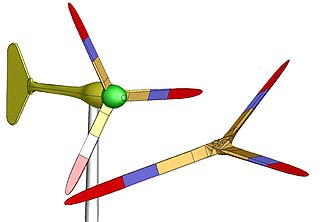
Small wind turbines, also known as micro wind turbines, are used for microgeneration of electricity, as opposed to large commercial wind turbines, such as those found in wind farms. Small wind turbines often have passive yaw systems as opposed to active ones. They use a direct drive generator and use a tail fin to point into the wind, whereas larger turbines have geared powertrains that are actively pointed into the wind.

Wind turbine design is the process of defining the form and configuration of a wind turbine to extract energy from the wind. An installation consists of the systems needed to capture the wind's energy, point the turbine into the wind, convert mechanical rotation into electrical power, and other systems to start, stop, and control the turbine.
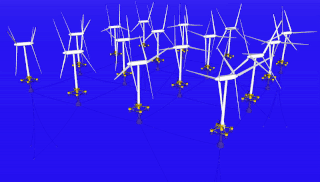
Unconventional wind turbines are those that differ significantly from the most common types in use.
A load-following power plant, regarded as producing mid-merit or mid-priced electricity, is a power plant that adjusts its power output as demand for electricity fluctuates throughout the day. Load-following plants are typically in between base load and peaking power plants in efficiency, speed of start-up and shut-down, construction cost, cost of electricity and capacity factor.

Siemens Gamesa Renewable Energy S.A., formerly Gamesa Corporación Tecnológica S.A. and Grupo Auxiliar Metalúrgico S.A., is a Spanish-German wind engineering company based in Zamudio, Biscay, Spain. It manufactures wind turbines and provides onshore and offshore wind services. It is the world's second largest wind turbine manufacturer.
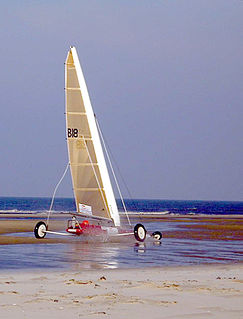
Wind-powered vehicles derive their power from sails, kites or rotors and ride on wheels—which may be linked to a wind-powered rotor—or runners. Whether powered by sail, kite or rotor, these vehicles share a common trait: As the vehicle increases in speed, the advancing airfoil encounters an increasing apparent wind at an angle of attack that is increasingly smaller. At the same time, such vehicles are subject to relatively low forward resistance, compared with traditional sailing craft. As a result, such vehicles are often capable of speeds exceeding that of the wind.
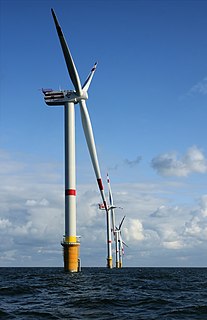
A wind turbine is a device that converts the kinetic energy of wind into electrical energy. Hundreds of thousands of large turbines, in installations known as wind farms, now generate over 650 gigawatts of power, with 60 GW added each year. Wind turbines are an increasingly important source of intermittent renewable energy, and are used in many countries to lower energy costs and reduce reliance on fossil fuels. One study claimed that, as of 2009, wind had the "lowest relative greenhouse gas emissions, the least water consumption demands and the most favorable social impacts" compared to photovoltaic, hydro, geothermal, coal and gas energy sources.

Offshore wind power or offshore wind energy is the generation of electricity through wind farms in bodies of water, usually at sea. There are higher wind speeds offshore than on land, so offshore farms generate more electricity per amount of capacity installed. Offshore wind farms are also less controversial than those on land, as they have less impact on people and the landscape.
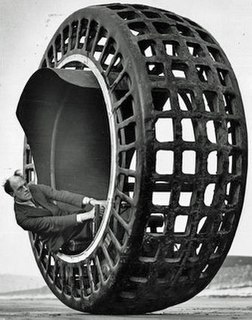
The Dynasphere was a monowheel vehicle design patented in 1930 by John Archibald Purves FRSE from Taunton, Somerset, UK. Purves' idea for the vehicle was inspired by a sketch made by Leonardo da Vinci.

Blackbird is an experimental wind-powered vehicle, built in 2010 to demonstrate that it is possible for such a vehicle to go directly downwind faster than the wind. Blackbird employs a rotor connected to the wheels and does not have a motor, battery or flywheel. It was constructed by Rick Cavallaro and John Borton of Sportvision, sponsored by Google and Joby Energy in association with the San Jose State University aeronautics department.

Starting in 1975, NASA managed a program for the United States Department of Energy and the United States Department of Interior to develop utility-scale wind turbines for electric power, in response to the increase in oil prices. A number of the world's largest wind turbines were developed and tested under this pioneering program. The program was an attempt to leap well beyond the then-current state of the art of wind turbine generators, and developed a number of technologies later adopted by the wind turbine industry. The development of the commercial industry however was delayed by a significant decrease in competing energy prices during the 1980s.
The following outline is provided as an overview of and topical guide to wind energy:

Block Island Wind Farm is the first commercial offshore wind farm in the United States, located 3.8 miles (6.1 km) from Block Island, Rhode Island in the Atlantic Ocean. The five-turbine, 30 MW project was developed by Deepwater Wind. Construction began in 2015 and in late summer 2016 five Alstom Haliade 150-6-MW turbines were erected. Operations were launched in December 2016. It is the largest project using wind power in Rhode Island.
The Gougeon 32 is an American trailerable catamaran that was designed by Jan Gougeon and first built in 1990.

MSC ADAMS is a multibody dynamics simulation software system. It is currently owned by MSC Software Corporation. The simulation software solver runs mainly on Fortran and more recently C++ as well. According to the publisher, Adams is the most widely used multibody dynamics simulation software. The software package runs on both Windows and Linux.

A vertical-axis wind turbine (VAWT) is a type of wind turbine where the main rotor shaft is set transverse to the wind while the main components are located at the base of the turbine. This arrangement allows the generator and gearbox to be located close to the ground, facilitating service and repair. VAWTs do not need to be pointed into the wind, which removes the need for wind-sensing and orientation mechanisms. Major drawbacks for the early designs included the significant torque ripple during each revolution, and the large bending moments on the blades. Later designs addressed the torque ripple by sweeping the blades helically. Savonius vertical-axis wind turbines (VAWT) are not widespread, but their simplicity and better performance in disturbed flow-fields, compared to small horizontal-axis wind turbines (HAWT) make them a good alternative for distributed generation devices in an urban environment.















